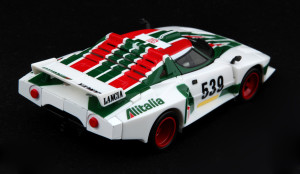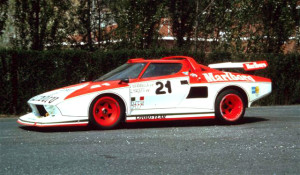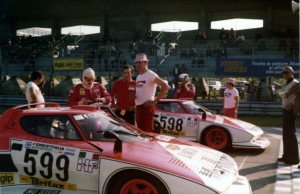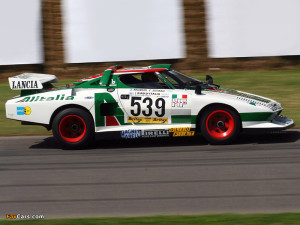Wheeljack has always fascinated me. His alternate mode, the Group 5 Lancia Stratos Turbo, stood out like a sore thumb among the Autobot Cars: it was not quite an exotic like Sideswipe, though it was wide and flat, but it didn’t look like a racer either: certainly Mirage belonged in F1, and certainly Jazz belonged in road racing, but what was this weapon-looking, spoiler-tastic, flare-fendered monstrosity?


Masterpiece Wheeljack brings this wild vehicle into finer focus. The Lancia Stratos was designed after Ferrari agreed to furnish enough of the rugged and powerful Dino (pronounced DEE-no) engine for Lancia’s Group 4 off-road rally racing program. The car was basically shrink-wrapped around the 315 bhp (235 kW) engine, using a jacked-up off-road racing suspension. The tiny car dominated rally racing for 3 years straight, mopping up nearly every race. A few hundred “road cars” were produced to homologate the car. These cars are described by their owners and drivers as barely-contained balls of automotive rage, with one Petrolicious interviewee saying the car was a “symphony of vaguely disastrous noises”


But Wheeljack’s bodywork is barely higher off the ground than well-cut grass. Clearly, he’s not the all-road supercar described above, right? Not quite. After the Stratos’ rally success, Lancia wanted to try their hand at the newly-created Group 5 silhouette road racing circuit, which would no doubt be dominated by the Renault Alpines and Porsche 911s (homologated as the Porsche 935-Jazz) of the day. Some tuning to the 24 valve Dino and a KKK turbocharger brought the Stratos up to a pavement-ripping 552 bhp (412 kW), and design firm Bertone provided new sheet metal to the car, giving it the wide stance, huge downforce spoilers, and the wide door sills like running boards… filled with fuel!

The first pair of Stratos Turbos had considerable problems with overheating, since the engine is in the back, and the turbocharger generates extra heat beyond what the engine already gave off. The #21 car caught fire during practice for its first race in 1976, and did not start. The car retired from its next race due to transmission troubles. Lancia revised the design, dramatically extending the tail and bringing more air into the engine bay, and built a second car following the new design, bringing them to the ‘76 Giro d’Italia Automobilistica as #598 and #599, in Marlboro Cigarrette livery. #598 won the race with Sandro Munari (a successful rally Stratos driver) and Carlo Facetti at the helm.


The turbo’s troubles were not over yet, however, and the former #599 car, (now numbered 25) caught fire and burned to the ground in practice for a race in Zeltweg, Austria.

The remining car came back again in 1977’s Giro d’Italia, now sponsored by the airline Alitalia and badged #539. Sound familiar? Sandro Munari and Piero Sodano drove the car to victory, and planned to race again at Mount Fuji, Japan in the Formula Silhouette. However, the race was not run, and the car was sold to a private Japanese collector, and disappeared from the public eye for nearly 30 years, until it was bought by Stratos collector Christian Hrabalek, still in its Alitalia 539 livery from the day of its victory in 1977.
Two full races, two victories. Why was the car abandoned when it saw these successes? The death of the car’s lead designer in 1977 may have contributed, but a bigger part of its failure was its inability to compete in longer (i.e. 24 hour) races with the Porsche 935 aka Jazz, the dominant predator of the endurance tracks at the time.

So who the heck is Exhaust?

During the Pre-Transformers series Diaclone, many of the Car Robots that became transformers were produced in more than one deco. The robots didn’t represent individual characters, but rather mecha built to defend the Earth, so they weren’t necessarily unique… commercials and advertisements picture swarms of the same toy operating together. In the case of Lancia Stratos Turbo, the two decos chosen (including a new head sculpt) were the two Giro d’Italia decos used during its victories.
Exhaust, previously known among Transfans as “Marlboor Wheeljack” for his intentionally-mispelled sponsor logos, has often been included in fanon under various names poking fun at his tobacco promoting. Exhaust seems to follow this theme.
What I’ve discovered in my reading about the Stratos Turbo, though, is that there may have only been two constructed. #599/25’s remains are in the ground at Zeltweg, Austria… Perhaps leaving only #598, later repainted in Alitalia colors as #539. It’s quite possible that Exhaust IS Wheeljack!




This Article was super informative and entertaining. I just listened to the episode of transmissions featuring Ben as a guest. I had no idea your website had expanded so much. I hope to do business with tfland in the future.